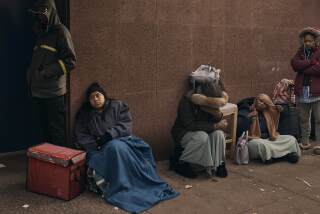. . . But City Violence Still Fuels Exodus
SCARSDALE, N.Y. — Dr. Glenn Fishman and his wife, Joanne Wallenstein, wanted to stick it out in New York. But the city wore them down.
Their car was broken into eight times in 12 months. They were mugged, hassled by homeless beggars, frightened on the subway at night. They didn’t want to witness the final urban terror: murder.
More than a home, the couple and their two young children finally sought a haven here, in this gabled suburb about 40 minutes from New York by train.
“We feel bad abandoning the city,” said Fishman, a researcher at Albert Einstein College of Medicine. “But the problems seem to be growing at such a clip that a lot of people . . . are finding it’s a good time to make a move.”
Added his wife, Joanne: “It’s sad for the city.”
There is much for the city to mourn. Statistics usually reserved for Harlem and Flatbush are touching “safe” neighborhoods. It is more difficult for people to ignore the violence, step over the many beggars in their path.
New York’s welfare caseload numbers 830,000--greater than the population of all but America’s 10 largest cities. Someone is robbed every six minutes and an average of 366 cars are stolen daily. Among the subway users, about 200,000 jump the turnstiles and ride free each day.
“Violence is reaching people it never reached before,” said Ellen Kaidanow, 30, an executive recruiter for The Gap Inc.
“It used to be that there were certain parts of Manhattan where you felt relatively safe,” said Kaidanow, who is looking for a suburban home where she and her husband can start a family. “Now the violence could be anywhere.”
It is this sense of randomness that drives many couples back to the secure, relatively quiet suburban lifestyle they knew as children and, in many cases, swore off as young adults.
The U.S. Census Bureau doesn’t break down New York metropolitan area migration, but suburban real estate agents say that weary urban couples looking for a change lately have given their slumping market a modest boost.
“Many think the city isn’t getting any better and a lot . . . think it’s going to get worse,” said Merritt Mitchell, president of the Westchester Multiple Listings Service. “A lot of young couples are looking to get out.”
But along with the contents of their apartments, many ex-New Yorkers end up bringing a sense of guilt with them to the suburbs, where homes start at about $175,000. Their consciences suggest that it would be nobler to stay and fight for the city’s future.
“But you have to look at it from a standpoint of self-preservation,” said Marc Tartell, 36, advertising director at A&W; Brands Inc. “Things felt out of control.”
As the Tartells were packing up a moving van bound for Westchester County in September, someone stole two suitcases stuffed with their children’s baby clothes. The theft was a final kick in the pants, a reminder of why the longtime New Yorkers were getting out.
“I like city living. I just don’t like living in New York anymore,” said Barbara Tartell, 31, a vice president at Goldman, Sachs & Co. “The presence of undesirable people is becoming more obvious.”
Jobless, angry, addicted young people used to hang out near the Tartell’s home on the Upper West Side. Their 3-year-old son already was asking about prostitution, crack cocaine and homelessness.
Their new two-story, five-bedroom colonial home is altogether different. The kids have a back yard now, trees to swing from, a street made for “kick the can” and neighborhood pals ready to play such games.
Local taxes are higher, but the public schools in Scarsdale aren’t overcrowded and underfunded like those in the city. And the $7,500 kindergarten tuition the Tartells faced in New York was anything but cheap.
New suburbanites say they wish their kids could grow up with the city’s energy, culture and diversity. But those things mean nothing, parents say, if their children are frightened, stressed out, constantly on edge.
“It’s a fight or flight situation,” said Charlie Clough, an abstract artist who shares a Greenwich Village townhouse with his wife and their two young sons. “It’s palpable . . . these are real bullets going by.”
More to Read
Sign up for Essential California
The most important California stories and recommendations in your inbox every morning.
You may occasionally receive promotional content from the Los Angeles Times.










